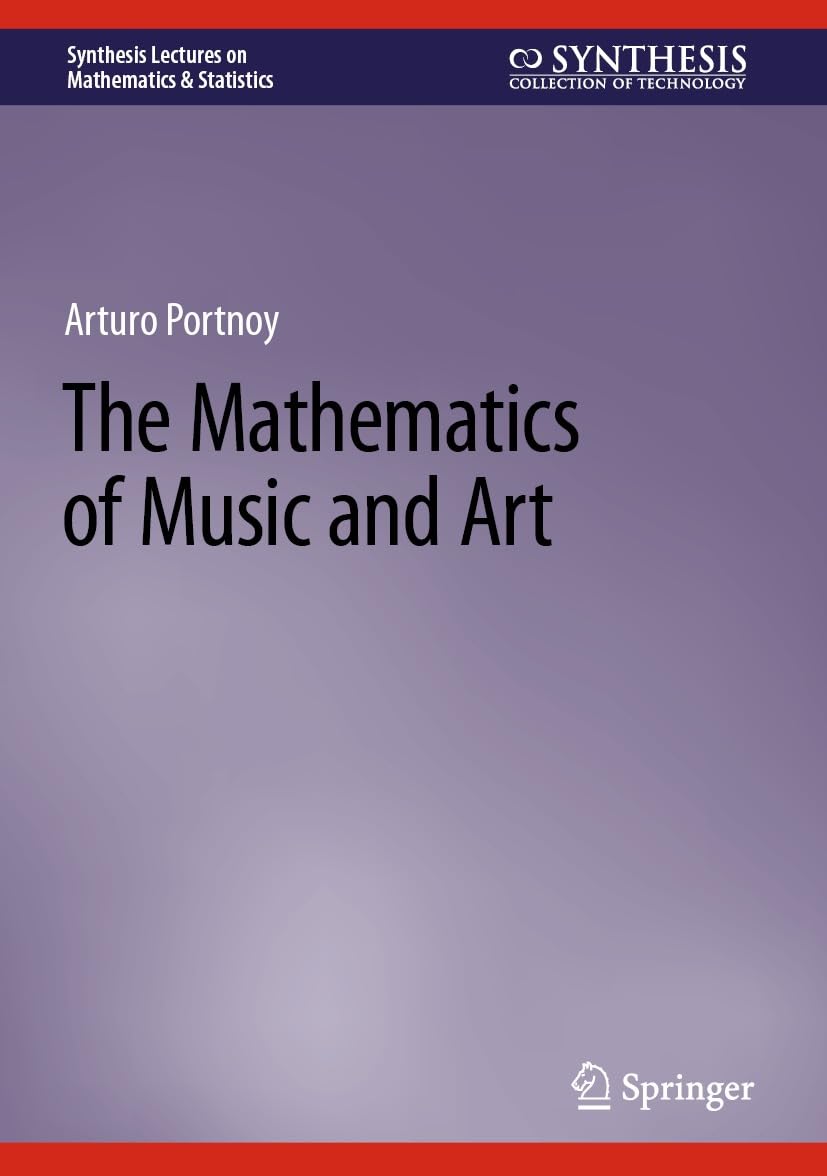
- Author: Arturo Portnoy
- Series: Synthesis Lectures on Mathematics & Statistics (SLMS)
- Publisher: Springer
- Publication Date: 07/29/2024
- Number of Pages: 153
- Format: Electronic Book
- Price: $37.99
- ISBN: 978-3031344428
- Category: gen
[Reviewed by Geoffrey D. Dietz, on 11/12/2024]
The textbook under review presents the connections between the physical theory of sound, music theory, and mathematics to a general audience. It is based upon an interdisciplinary course co-taught by the author with a musicologist and a physicist. The two topics of music and mathematics are nicely woven throughout the course with each chapter having a mixture of both sides.
The author starts with rational numbers, continued fractions, and Dirichlet’s theorem on rational approximation. Armed with these ideas, he moves quickly into Pythagoras, the Circle of Fifths, and early music theory. Anyone who has ever played a guitar or piano will appreciate the connections between modes of vibration for a string and the pleasant harmony produced by simultaneously playing a base tone and another tone with 3/2 the frequency of the base. (Wind instruments are mentioned too but greater focus is given to string-powered instruments.)
The problem of how to build a scale then arises because one cannot “close the loop” of powers of 3/2 syncing up with a power of 2. What comes close? The powers 5, 7, and 12 give $(\frac{3}{2})5 ≈ 23$, $(\frac{3}{2})7 ≈ 24$, and $(\frac{3}{2})12 ≈ 27$, which in turn lead to the familiar pentatonic, seven-note major, and twelve-note chromatic scales. The next such power would require a 41-note scale, which is generally considered too large. Settling on a twelve-note scale then leads to the problem of where to pitch the twelve notes of the scale and the various theories of temperament, which are used when tuning pianos or placing frets on a guitar. Other topics include analysis of rhythm patters, sound waves and Fourier analysis, and approximating analog sound with a digital, binary encoding.$$
Although this review has so far concentrated in the text itself, it has so far ignored one of the outstanding features of this book. Scattered throughout each chapter is a collection of activities. Some are exercises to test and stretch understanding, but the vast majority are online activities accessible through a free companion website associated with the book. These well-crafted activities will allow you to visualize, hear, and experiment with nearly every topic discussed in the book. Readers will be able to see and experiment with graphical topics through saved Desmos projects, listen to various tones and harmonies using Chrome Music Lab interaction, or see and hear more on a topic through links to YouTube videos. Mathematicians and musicians agree that learning facts and terms are important, but that practice and exercise are necessary to really learn both of our topics well. The activities in this text will greatly aid the reader in understanding and engagement. While this reviewer believes the activities are an excellent addition to the text, this reviewer is also old-fashioned and found the idea of needing a tablet or laptop at hand while progressing through the book to be occasionally stressful.
I mostly enjoyed the book, but I will quibble with the “and Art” part of the title. There is a brief mention of the Golden Rectangle and Fibonacci spiral, but otherwise music is the only artistic application. The author is also quick to point out that his book only concerns Western or Euro-centric music theory and history due to his own knowledge and expertise. He does include Afro-Caribbean influences in his chapter on pattern and rhythm when discussing syncopation. My only other minor disappointment came from the sense that the book does not dive deeply enough sometimes. For example, there is a passing reference made to modular arithmetic and its uses in music theory, but other than seven brief lines of text, no further mention is made of this rich topic.
The book largely succeeds in its goals to reach out to a broad audience who has interests in at least one of music or mathematics. A person interested in both will probably profit the most from the book, but a person not well-versed in either topic will learn many new things. The book can be enjoyed on its own or could be used as the foundation for an interdisciplinary course (as designed by the author) or a first-year seminar course.
Geoffrey Dietz is a Professor of Mathematics at Gannon University in Erie, PA. He is married and has seven children. He has also been playing the guitar (poorly) for over thirty years.
